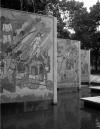Resumen
En la Venezuela de la década de 1950, el régimen presidido por el general Marcos Pérez Jiménez echó a andar uno delos programas de modernización de mayor impacto sobre el paisaje urbano del país, caracterizado por la aceptaciónplena de los códigos funcionales y abstractos del llamado “estilo internacional”, en particular para edificios de usopúblico. Sin embargo, en muchas de estas obras que intentaban materializar una visión “moderna” –pero nacionalista–del país, se incluyeron, paradójicamente, elementos artísticos inspirados en el pasado prehispánico, en unsincretismo de códigos que, apoyado sobre la base de supuestos testimonios de las culturas originarias, legitimabael “gran salto” hacia el desarrollo. El trabajo elabora una interpretación en términos simbólicos de la hibridaciónde lenguajes –moderno e “indigenista”– presente en algunas de las obras públicas más importantes erigidas en lacapital durante la dictadura, con especial énfasis en los casos de la Ciudad Universitaria-Autopista del Este, el CentroSimón Bolívar y el Círculo Militar, en los cuales coexisten fórmulas de la arquitectura moderna junto con elementosartísticos que “re-crean” mitos y tradiciones de las culturas indígenas venezolanas.La revista Apuntes se encuentra registrada bajo la licencia Creative Commons Reconocimiento 4.0 Internacional. Por lo tanto, esta obra se puede reproducir, distribuir y comunicar públicamente en formato digital, siempre que se reconozca el nombre de los autores y a la Pontificia Universidad Javeriana. Se permite citar, adaptar, transformar, autoarchivar, republicar y crear a partir del material, para cualquier finalidad (incluso comercial), siempre que se reconozca adecuadamente la autoría, se proporcione un enlace a la obra original y se indique si se han realizado cambios. La Pontificia Universidad Javeriana no retiene los derechos sobre las obras publicadas y los contenidos son responsabilidad exclusiva de los autores, quienes conservan sus derechos morales, intelectuales, de privacidad y publicidad.
El aval sobre la intervención de la obra (revisión, corrección de estilo, traducción, diagramación) y su posterior divulgación se otorga mediante una licencia de uso y no a través de una cesión de derechos, lo que representa que la revista y la Pontificia Universidad Javeriana se eximen de cualquier responsabilidad que se pueda derivar de una mala práctica ética por parte de los autores. En consecuencia de la protección brindada por la licencia de uso, la revista no se encuentra en la obligación de publicar retractaciones o modificar la información ya publicada, a no ser que la errata surja del proceso de gestión editorial. La publicación de contenidos en esta revista no representa regalías para los contribuyentes.


